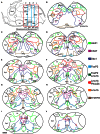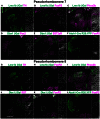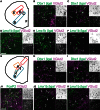Transcription factors define the neuroanatomical organization of the medullary reticular formation
- PMID: 23717265
- PMCID: PMC3653110
- DOI: 10.3389/fnana.2013.00007
Transcription factors define the neuroanatomical organization of the medullary reticular formation
Abstract
The medullary reticular formation contains large populations of inadequately described, excitatory interneurons that have been implicated in multiple homeostatic behaviors including breathing, viserosensory processing, vascular tone, and pain. Many hindbrain nuclei show a highly stereotyped pattern of localization across vertebrates suggesting a strong underlying genetic organization. Whether this is true for neurons within the reticular regions of hindbrain is unknown. Hindbrain neurons are derived from distinct developmental progenitor domains each of which expresses distinct patterns of transcription factors (TFs). These neuronal populations have distinct characteristics such as transmitter identity, migration, and connectivity suggesting developmentally expressed TFs might identify unique subpopulations of neurons within the reticular formation. A fate-mapping strategy using perinatal expression of reporter genes within Atoh1, Dbx1, Lmx1b, and Ptf1a transgenic mice coupled with immunohistochemistry (IHC) and in situ hybridization (ISH) were used to address the developmental organization of a large subset of reticular formation glutamatergic neurons. All hindbrain lineages have relatively large populations that extend the entire length of the hindbrain. Importantly, the location of neurons within each lineage was highly constrained. Lmx1b- and Dbx1- derived populations were both present in partially overlapping stripes within the reticular formation extending from dorsal to ventral brain. Within each lineage, distinct patterns of gene expression and organization were localized to specific hindbrain regions. Rostro-caudally sub-populations differ sequentially corresponding to proposed pseudo-rhombomereic boundaries. Dorsal-ventrally, sub-populations correspond to specific migratory positions. Together these data suggests the reticular formation is organized by a highly stereotyped developmental logic.
Keywords: brainstem; development; fate-mapping; hindbrain; reticular formation; rhombomeres; transcription factors.
Figures









Similar articles
-
Inhibitory and excitatory subtypes of cochlear nucleus neurons are defined by distinct bHLH transcription factors, Ptf1a and Atoh1.Development. 2009 Jun;136(12):2049-58. doi: 10.1242/dev.033480. Epub 2009 May 13. Development. 2009. PMID: 19439493
-
Morphology of Dbx1 respiratory neurons in the preBötzinger complex and reticular formation of neonatal mice.Sci Data. 2017 Aug 1;4:170097. doi: 10.1038/sdata.2017.97. Sci Data. 2017. PMID: 28763053 Free PMC article.
-
Segmental development of reticulospinal and branchiomotor neurons in lamprey: insights into the evolution of the vertebrate hindbrain.Development. 2004 Mar;131(5):983-95. doi: 10.1242/dev.00986. Development. 2004. PMID: 14973269
-
Axonal Projection Patterns of the Dorsal Interneuron Populations in the Embryonic Hindbrain.Front Neuroanat. 2021 Dec 24;15:793161. doi: 10.3389/fnana.2021.793161. eCollection 2021. Front Neuroanat. 2021. PMID: 35002640 Free PMC article. Review.
-
Distribution of cholinergic, GABAergic and serotonergic neurons in the medial medullary reticular formation and their projections studied by cytotoxic lesions in the cat.Neuroscience. 1994 Oct;62(4):1155-78. doi: 10.1016/0306-4522(94)90351-4. Neuroscience. 1994. PMID: 7845592 Review.
Cited by
-
Chronology-based architecture of descending circuits that underlie the development of locomotor repertoire after birth.Elife. 2019 Feb 25;8:e42135. doi: 10.7554/eLife.42135. Elife. 2019. PMID: 30801247 Free PMC article.
-
Breathing matters.Nat Rev Neurosci. 2018 Jun;19(6):351-367. doi: 10.1038/s41583-018-0003-6. Nat Rev Neurosci. 2018. PMID: 29740175 Free PMC article. Review.
-
Loss of Ptf1a Leads to a Widespread Cell-Fate Misspecification in the Brainstem, Affecting the Development of Somatosensory and Viscerosensory Nuclei.J Neurosci. 2016 Mar 2;36(9):2691-710. doi: 10.1523/JNEUROSCI.2526-15.2016. J Neurosci. 2016. PMID: 26937009 Free PMC article.
-
The interdependence of excitation and inhibition for the control of dynamic breathing rhythms.Nat Commun. 2018 Feb 26;9(1):843. doi: 10.1038/s41467-018-03223-x. Nat Commun. 2018. PMID: 29483589 Free PMC article.
-
Dbx1 precursor cells are a source of inspiratory XII premotoneurons.Elife. 2015 Dec 19;4:e12301. doi: 10.7554/eLife.12301. Elife. 2015. PMID: 26687006 Free PMC article.
References
-
- Almeida A., Lima D. (1997). Activation by cutaneous or visceral noxious stimulation of spinal neurons projecting to the medullary dorsal reticular nucleus in the rat: a c-fos study. Eur. J. Neurosci. 9, 686–695 - PubMed
Grants and funding
LinkOut - more resources
Full Text Sources
Other Literature Sources

